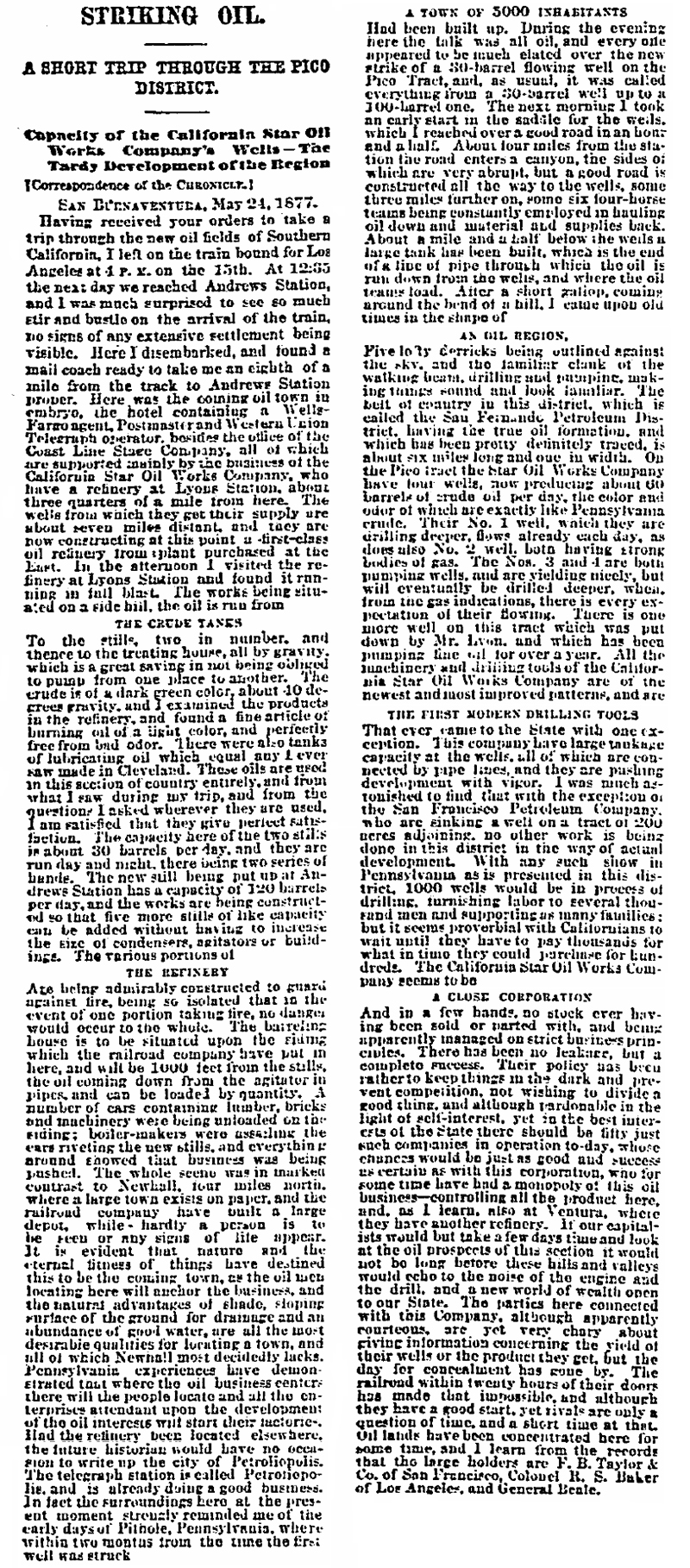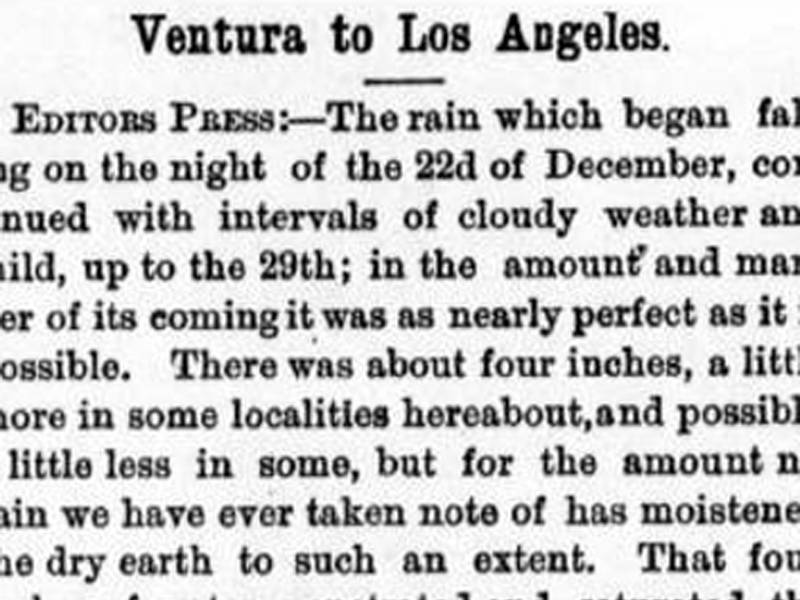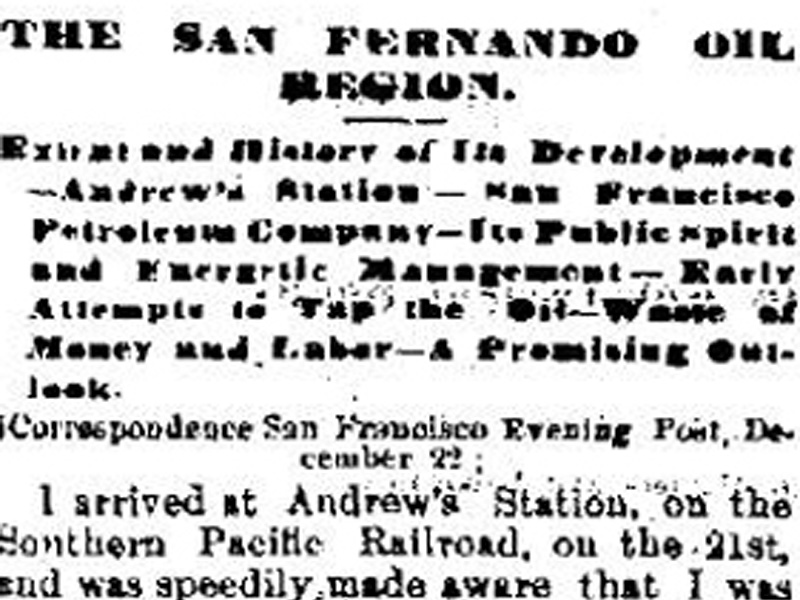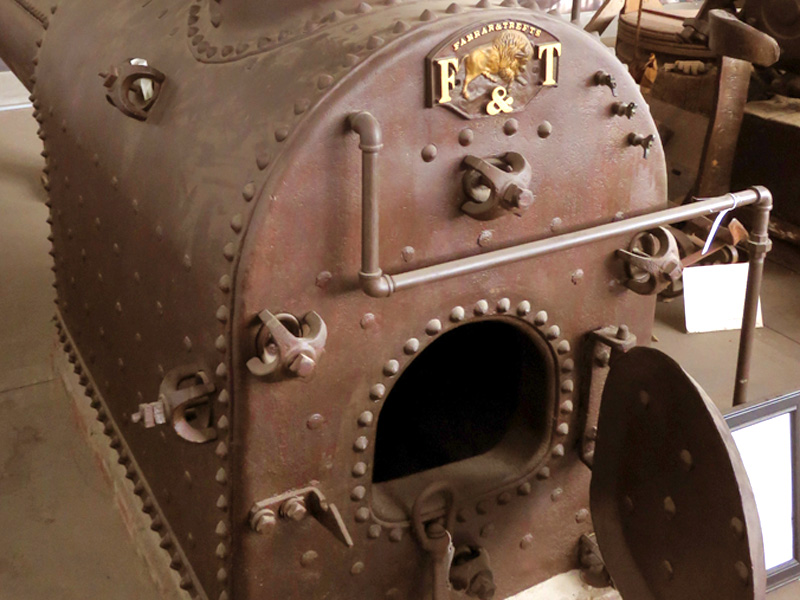|
|

Petroliopolis: Pico Oil District; Refineries at Lyon's, Andrews.
San Francisco Chronicle | May 28, 1877.
|
Webmaster's note.
Historian Stan Walker summarizes: In May 1877, Andrew's Station (which was not a Southern Pacific train station) contained a telegraph, a Wells, Fargo agent and a postmaster. A siding 1,000 feet from the still-under-construction Pioneer Oil Refinery was built by the railroad. There is no spur yet. The refined oil will be piped down to a barreling house, soon to be built. The barrels can then be loaded onto the railroad cars from that point. The Lyon's Station refinery (at today's Eternal Valley Cemetery) is still being used. There is a Southern Pacific railroad depot in Newhall, but not too many people.
STRIKING OIL. A Short Trip Through the Pico District. Capacity of the California Star Oil Works Company's Wells — the Tardy Development of the Region
San Francisco Chronicle | May 28, 1877 Having received your orders to take a trip through the new oil fields of Southern California, I left on the train bound for Los Angeles at 4 P.M. on the 15th. At 12:35 the next day we reached Andrews Station, and I was much surprised to see so much stir and bustle on the arrival of the train, no signs of any extensive settlement being visible. Here I disembarked, and found a mail coach ready to take me an eighth of a mile from the track to Andrews Station proper. Here was the coming oil town in embryo, the hotel containing a Wells-Fargo agent, Postmaster and Western Union Telegraph operator, besides the office of the Coast Line Stage Company, all of which are supported mainly by the business of the California Star Oil Works Company, who have a refinery at Lyons Station, about three quarters of a mile from here. The wells from which they get their supply are about seven miles distant, and they are now constructing at this point a first-class oil refinery from a plant purchased at the East. In the afternoon I visited the refinery at Lyons Station and found it running in full blast. The works being situated on a side hill, the oil is run from THE CRUDE TANKS To the stills, two in number, and thence to the treating house, all by gravity, which is a great saving in not being obliged to pump from one place to another. The crude is of a dark green color, about 10 degrees gravity, and I examined the products in the refinery and found a fine article of burning oil of a light color, and perfectly free from bad odor. There were also tanks of lubricating oil which equal any I have ever saw made in Cleveland. These oils are used in this section of the country entirely, and from what I saw during my trip, and from the questions I asked wherever they are used, I am satisfied that they give perfect satisfaction. The capacity here of the two stills is about 30 barrels per day, and they are run day and night, there being two series of hands. The new still being put up at Andrews Station has a capacity of 120 barrels per day, and the works are being constructed so that five more stills of like capacity can be added without having to increase the size of condensers, agitators or buildings. The various portions of THE REFINERY Are being admirably constructed to guard against fire, being so isolated that in the event of one portion taking fire, no danger would occur to the whole. The barreling house is to be situated upon the siding which the railroad company have put in here, and will be 1000 feet from the stills, the oil coming down from the agitator in pipes, and can be loaded by quantity. A number of cars containing lumber, bricks and machinery were being unloaded on the siding; boiler-makers were assailing the cars riveting the new stills, and everything around showed that business was being pushed. The whole scene was in marked contrast to Newhall, four miles north, where a large town exists on paper, and the railroad company have built a large depot, while hardly a person is to be seen or any signs of life appear. It is evident that nature and the eternal fitness of things have destined this to be the coming town, as the oil men locating here will anchor the business, and the natural advantages of shade, sloping surface of the ground for drainage and an abundance of good water, are all the most desirable qualities for locating a town, and all of which Newhall most decidedly lacks. Pennsylvania experiences have demonstrated that where the oil business centers there will the people locate and all the enterprises attendant upon the development of the oil interests will start their factories. Had the refinery been located elsewhere, the future historian would have no occasion to write up the city of Petroliopolis. The telegraph station is called Petroliopolis, and is already doing a good business. In fact the surroundings here at the present moment strongly reminded me of the early days of Pithole, Pennsylvania, where within two months from the time the first well was struck A TOWN OF 3000 INHABITANTS Had been built up. During the evening here the talk was all oil, and every one appeared to be much elated over the strike of a 30-barrel flowing well on the Pico Tract, and, as usual, it was called everything from a 30-barrel well up to a 100-barrel one. The next morning I took an early start in the saddle for the wells, which I reached over a good road in and hour and a half. About four miles from the station the road enters a canyon, the sides of which are very abrupt, but a good road is constructed all the way to the wells, some three miles further on, some six four-horse teams being constantly employed in hauling oil down and materials and supplies back. About a mile and a half below the wells a large tank has been built, which is the end of a line of pipe through which the oil is run down from the wells, and where the oil teams load. After a short gallop, coming around the bend of a hill, I came upon old times in the shape of AN OIL REGION, Five lofty derricks being outlined against the sky, and the familiar clank of the walking beam, drilling and pumping, making things sound and look familiar. The belt of country in this district, which is called the San Fernando Petroleum District, having the true oil formation, and which has been pretty definitely traced, is about six miles long and one in width. On the Pico tract the Star Oil Works Company have four wells, now producing about 60 barrels of crude oil per day, the color and odor of which are exactly like Pennsylvania crude. Their No. 1 well, which they are drilling deeper, flows already each day, as does the No. 2 well, both having strong bodies of gas. The Nos. 3 and 4 are both pumping wells, and are yielding nicely, but will eventually be drilled deeper, when, from the gas indications, there is every expectation of their flowing. There is one more well on this tract which was put down by Mr. Lyon, and which has been pumping fine oil for over a year. All the machinery and drilling tools of the California Star Oil Works Company are of the newest and most improved patterns, and are THE FIRST MODERN DRILLING TOOLS That ever came to the state with one exception. This company have large tankage capacity at the wells, all of which are connected by pipe lines, and they are pushing development with vigor. I was much astonished to find that with the exception of the San Francisco Petroleum Company, who are sinking a well on a tract of 200 acres adjoining, no other work is being done in this district in the way of actual development. With any such show in Pennsylvania as is presented in this district, 1000 wells would be in process of drilling, furnishing labor to several thousand men and supporting as many families; but it seems proverbial with Californians to wait until they have to pay thousands for what in time they could purchase for hundreds. The California Star Oil Works Company seems to be A CLOSE CORPORATION And in a few hands, no stock ever having been sold or parted with, and being apparently managed on strict business principles. There has been no leakage, but a complete success. Their policy has been rather to keep things in the dark and prevent competition, not wishing to divide a good thing, and although pardonable in the light of self-interest, yet in the best interests of the State there should be fifty just such companies in operation today, whose chances would be just as good and success as certain as with this corporation, who for some time have had a monopoly of this oil business - controlling all the product here and, as I learn, also at Ventura, where they have another refinery. If our capitalists would but take a few days time and look at the oil prospects of this section it would not be long before these hills and valleys would echo to the noise of the engine and the drill, and a new world of wealth open to our State. The parties here connected with the Company, although apparently courteous, are yet very wary about giving information concerning the yield of their wells or the product they get, but the day for concealment has gone by. The railroad within twenty hours of their doors has made that impossible, and although they have a good start, yet rivals are only a question of time, and a short time at that. Oil lands have been concentrated here for some time, and I learn from the records that the large holders are F. B. Taylor & Co. of San Francisco, Colonel R. S. Baker of Los Angeles, and General Beale.
News story courtesy of Stan Walker.
|
SEE ALSO:
• Story by Pollack
Description 1873
Kraszynski Sues to Recover Land 1874
Map August 1875
Visit March 1875
Description Jan. 1877
Description May 1877
Lyons Station House
Lyons Station Location 1875-1933
Sanford Lyon
Lyon Boy's Death 1881
Addi Lyon in the News
Sanford Lyon's Grave
Pioneer Cemetery
Pioneer Cemetery Location 1933-1966
Addi Lyon Obituary 1951
CSOW Time Book
1887-1889
CSOW Stock Certificate 1901
SCV History Moment
Early Oil & Gas Production in Calif. (Video 1985)
Standard Oil Co. History to 1929
Description Jan. 1877
Description May 1877
Description 9-26-1882
Oil Tank Const. & Death 1883
Mentryville 1885-1891
CSO Hill 1883
Oil Works ~1885
The Pico Field 1890
PCO Hill ~1890s
CSO Jackline Plant
Farrar & Trefts Boiler
New Boiler 1893?
Mentryville 1890s-1900s
Reamer Patent 1900
Machine Shop 1910
Machine Shop 1910s
Natural Gas-to-Gasoline 1913/14
Mentryville ~1920
Pico No. 4, 1931
CSO Jackline Plant
PCO Jackline Plant Remnants
Darryl Manzer at Firehouse ~1961
Darryl Manzer at Field Office ~1961
Pico No. 4, 1961
Darryl Manzer, L.A. Times Story 1962
National Survey 1963
PCO Jackline Plant Removal 1974-75
CSO Jackline Plant 1974-75
A.C. Mentry Blacksmith Forge
|
The site owner makes no assertions as to ownership of any original copyrights to digitized images. However, these images are intended for Personal or Research use only. Any other kind of use, including but not limited to commercial or scholarly publication in any medium or format, public exhibition, or use online or in a web site, may be subject to additional restrictions including but not limited to the copyrights held by parties other than the site owner. USERS ARE SOLELY RESPONSIBLE for determining the existence of such rights and for obtaining any permissions and/or paying associated fees necessary for the proposed use.














































